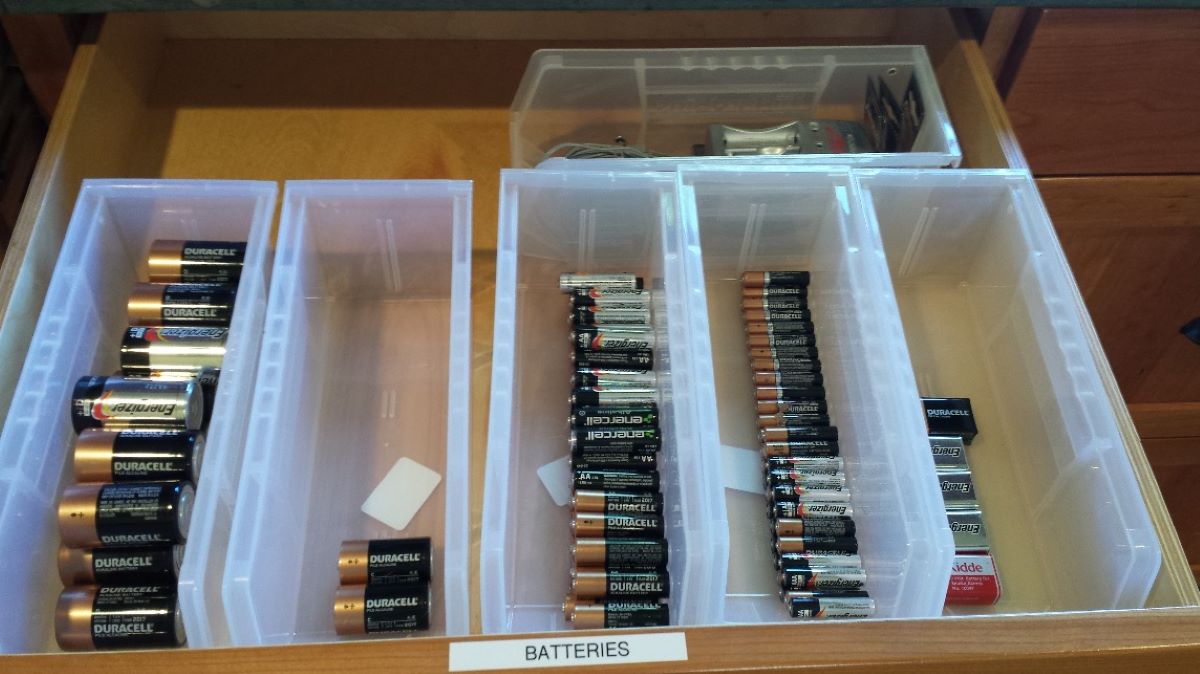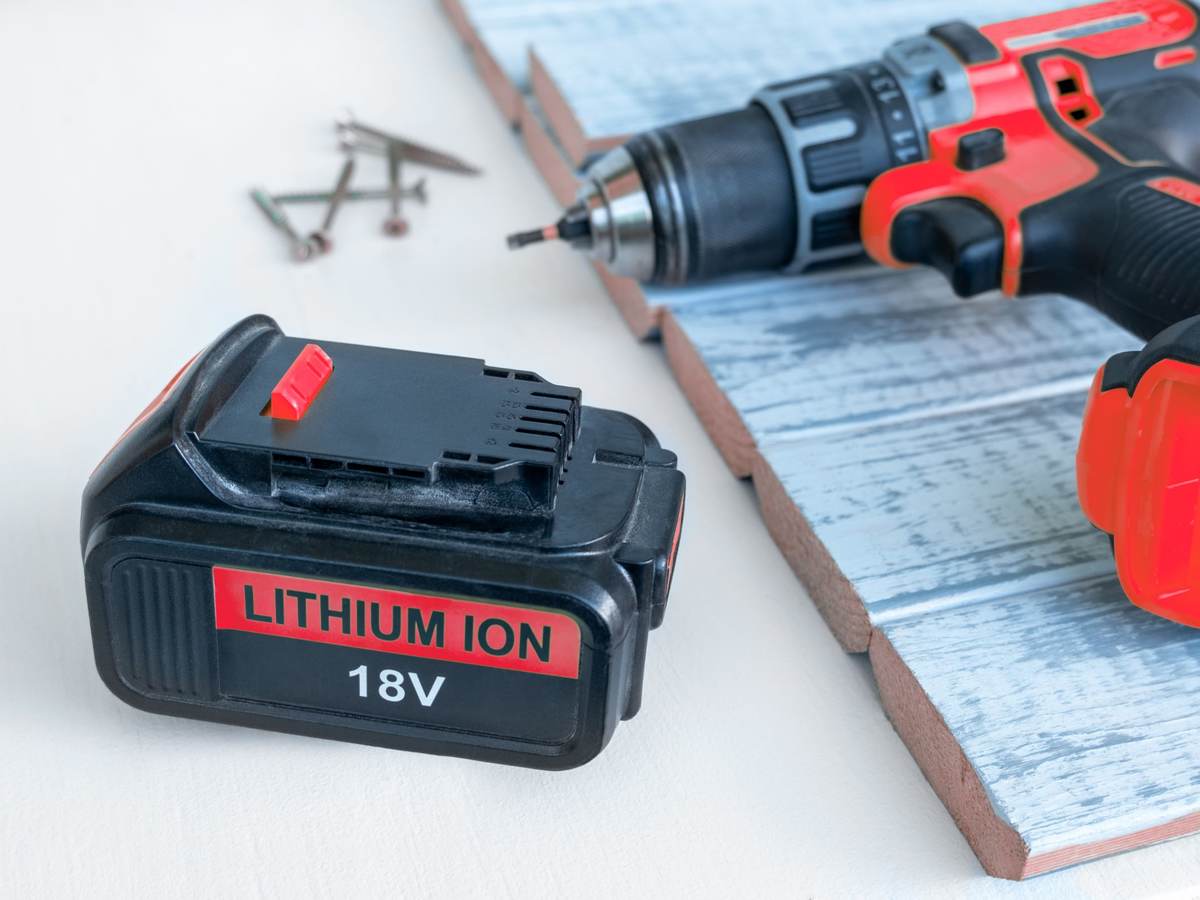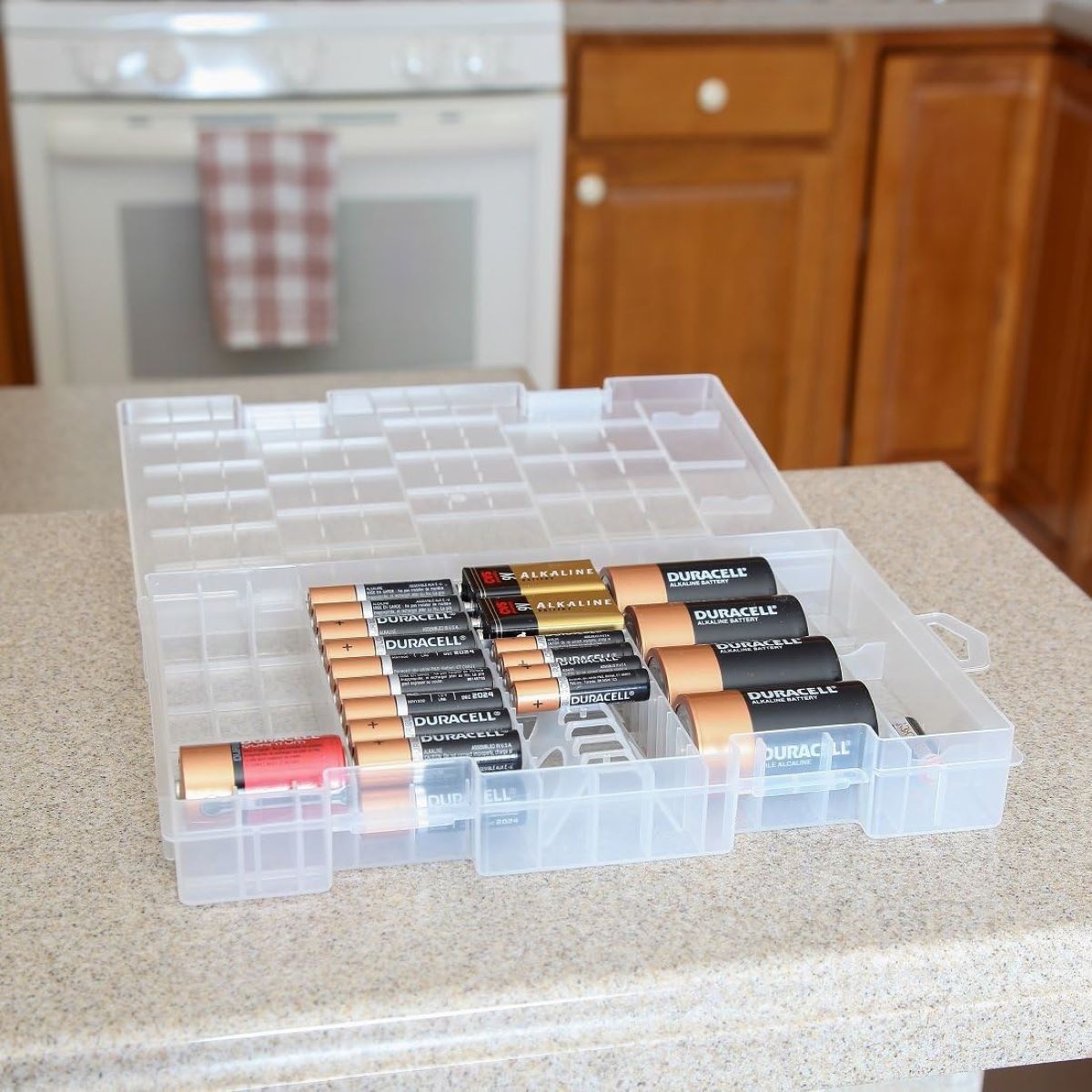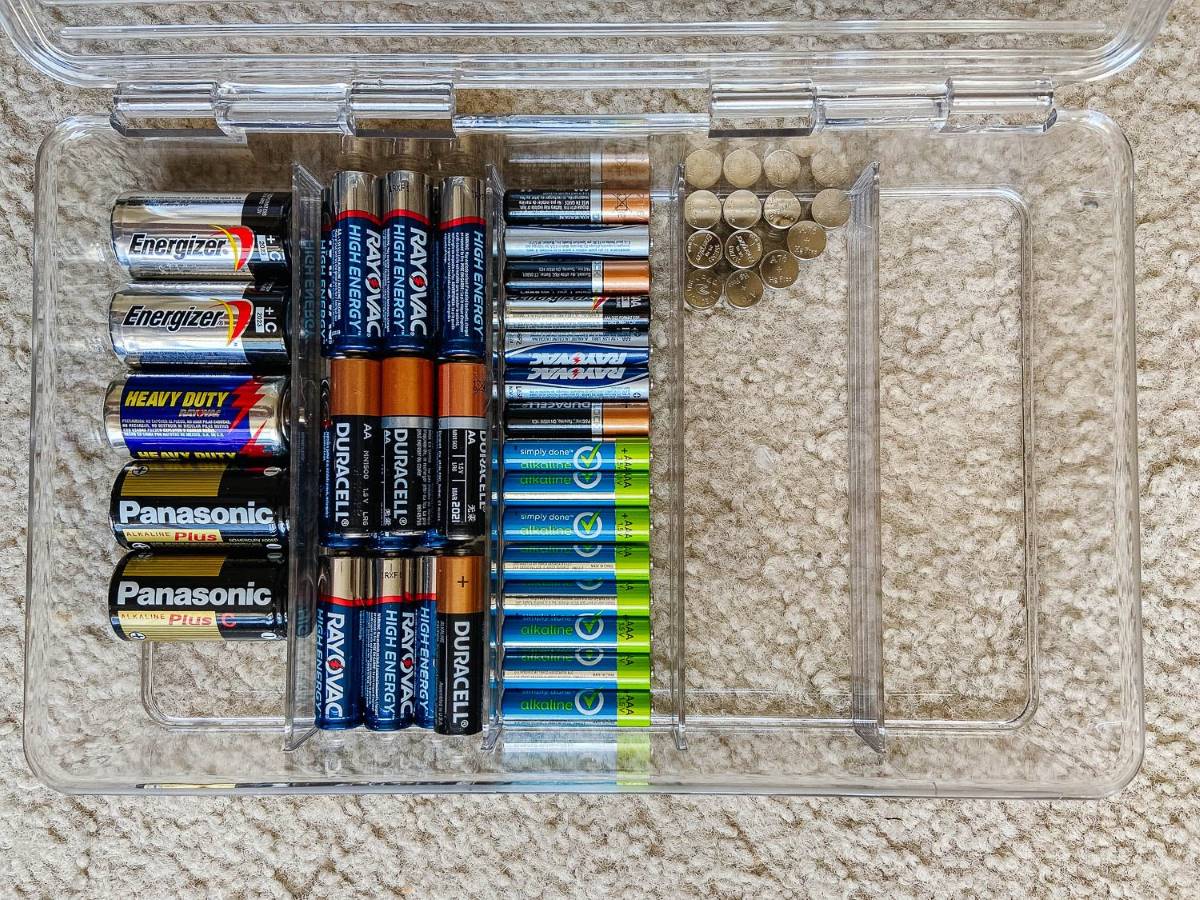

Articles
How To Store Lithium Batteries Safely
Modified: January 5, 2024
Learn how to safely store lithium batteries with our informative articles. Protect your batteries and prevent accidents with our expert tips.
(Many of the links in this article redirect to a specific reviewed product. Your purchase of these products through affiliate links helps to generate commission for Storables.com, at no extra cost. Learn more)
Introduction
Lithium batteries have become an essential part of our modern lives. From smartphones and laptops to electric vehicles and power tools, these rechargeable batteries offer convenience and portability. However, it is crucial to consider the safe storage of lithium batteries to prevent accidents and prolong their lifespan.
Lithium batteries are highly efficient and can store a significant amount of energy. While this makes them incredibly useful, it also increases the risk of fire or explosion if not handled or stored properly. Therefore, understanding how to safely store lithium batteries is vital for both personal safety and the longevity of these power sources.
In this article, we will explore the importance of safely storing lithium batteries and provide practical tips for ensuring their security. By implementing these guidelines, you can reduce the risk of accidents and protect yourself and your surroundings.
Key Takeaways:
- Safely storing lithium batteries is crucial to prevent fire hazards, gas release, and damage. Factors like temperature control, proper packaging, and following manufacturer guidelines are key to ensuring safe storage.
- Understanding the importance of safely storing lithium batteries and implementing proper storage practices can minimize risks, protect the environment, and prolong the lifespan of the batteries. Temperature control, ventilation, and insulation are essential for safe storage.
Read more: How To Store A Lithium Battery
Importance of Safely Storing Lithium Batteries
Safely storing lithium batteries is of paramount importance due to the potential risks associated with their improper handling and storage. These risks include fire hazards and the release of harmful gases, which can pose a threat to both personal safety and the environment.
One of the main concerns with lithium batteries is their high energy density. This means they contain a large amount of energy in a compact size. If not stored correctly, this energy can be released in an uncontrolled manner, leading to the ignition of the battery and surrounding materials. Proper storage helps to minimize the risk of thermal runaway, preventing catastrophic incidents.
In addition to fire hazards, lithium batteries can also release hazardous gases when exposed to certain conditions. For example, if a lithium battery is damaged or exposed to high temperatures, it can release toxic fumes and gases that are harmful to human health and the environment. Safe storage practices can minimize the chances of such incidents and keep the air clean and safe to breathe.
Furthermore, properly storing lithium batteries helps to preserve their performance and extend their lifespan. Exposure to extreme temperatures, humidity, or moisture can degrade the battery’s internal components and reduce its overall capacity. By storing batteries in a controlled and suitable environment, you can ensure they maintain their optimal performance for a longer period.
Ensuring the safe storage of lithium batteries is not only crucial for individuals but also for businesses and industries. Many industries rely on lithium batteries to power their operations, and accidents or malfunctions can have severe consequences. By observing proper storage practices and adhering to safety guidelines, businesses can mitigate the risk of accidents and protect their workforce, equipment, and facilities.
Overall, the importance of safely storing lithium batteries cannot be overstated. It is essential for personal safety, environmental protection, and the longevity of the batteries themselves. By implementing proper storage measures, you can enjoy the benefits of lithium batteries while minimizing risks and ensuring peace of mind.
Understanding Lithium Batteries
Lithium batteries are a type of rechargeable battery that is widely used due to its high energy density and long-lasting performance. They consist of one or more lithium cells, which store electrical energy through a process of lithium-ion movement between the positive and negative electrodes.
One of the key advantages of lithium batteries is their ability to provide a higher voltage and energy density compared to other types of batteries. This enables them to power a wide range of devices, from small electronic gadgets to electric vehicles and renewable energy systems.
Lithium batteries are commonly categorized into two main types: lithium-ion (Li-ion) and lithium polymer (LiPo) batteries. Li-ion batteries are the most common type and are used in a variety of applications. They typically contain a liquid electrolyte that facilitates the movement of lithium ions. LiPo batteries, on the other hand, utilize a solid or gel-like electrolyte, which offers flexibility in terms of form factor and design.
Understanding the basic characteristics of lithium batteries is crucial for safe storage. These batteries can be sensitive to environmental factors, such as temperature, humidity, and mechanical stress. Extreme temperatures, for example, can accelerate the degradation process and increase the risk of thermal runaway.
It is also important to note that lithium batteries have a limited lifespan and will gradually lose their capacity over time, even without use. This process, known as self-discharge, is influenced by factors such as temperature, charge level, and chemistry. Proper storage can help slow down the self-discharge rate and extend the battery’s overall lifespan.
Another critical aspect to consider is the correct handling and transportation of lithium batteries. This is especially important when shipping or travelling with lithium batteries, as they have specific regulations and guidelines to ensure safety. Ignoring these guidelines can result in accidents or even legal consequences.
In summary, lithium batteries are high-performance rechargeable power sources that offer numerous advantages. However, they require careful handling, storage, and transportation due to their chemical composition and sensitivity to environmental factors. By understanding the characteristics and requirements of lithium batteries, you can ensure their safe storage and optimal performance.
Factors to Consider for Safe Storage
When it comes to storing lithium batteries, several factors should be taken into consideration to ensure their safety and prevent potential hazards. Here are some key factors to consider when storing lithium batteries:
- Location: Choose a cool and dry location for storing lithium batteries. High temperatures can accelerate the aging process and increase the risk of fire or explosion. Avoid areas with direct sunlight or extreme temperature fluctuations, such as attics or vehicles parked in the sun.
- Container: Store lithium batteries in a non-conductive and flame-resistant container. This can include specialized battery storage cases or fireproof containers. Ensure the container is well-ventilated to dissipate any potentially hazardous gases.
- Separation: Keep lithium batteries separated from other metal objects, such as coins, keys, or aluminum foil. Metal objects can accidentally create a short circuit and cause the batteries to discharge rapidly, leading to overheating and potentially causing a fire.
- Isolation: Store lithium batteries in individual compartments or use insulating material to prevent contact between terminals. This reduces the risk of accidental discharge and minimizes the potential for short circuits.
- Labeling: Properly label and mark the storage containers or shelves to indicate the presence of lithium batteries. This will help remind individuals of the potential hazards and ensure that proper precautions are taken.
- No Water Exposure: Avoid exposing lithium batteries to water or high humidity levels. Moisture can corrode the battery terminals and contribute to the deterioration of the battery, reducing its performance and potentially causing a short circuit.
- No Aggressive Chemicals: Keep lithium batteries away from aggressive chemicals, such as acids, alkalis, or solvents. These substances can react with the battery’s components and pose a safety risk.
- No Physical Damage: Avoid dropping, puncturing, or crushing lithium batteries. Physical damage can lead to internal short circuits and increase the likelihood of thermal runaway.
- Charge Level: Store lithium batteries at around 50% charge. Storing them at full charge or fully discharged can accelerate capacity loss and decrease their overall lifespan.
- Manufacturer Guidelines: Always follow the manufacturer’s guidelines for storing lithium batteries. Different types of lithium batteries may have specific storage requirements and precautions that need to be observed.
By considering these factors and implementing proper storage practices, you can minimize the risk of accidents and ensure the safe storage of lithium batteries.
Storing Lithium Batteries in a Cool and Dry Location
Choosing the right storage location for lithium batteries is crucial to ensure their safety and maintain optimal performance. One of the primary considerations is to store lithium batteries in a cool and dry environment. Here’s why:
Temperature Control: Lithium batteries are sensitive to temperature extremes. High temperatures can accelerate the aging process and increase the risk of thermal runaway, while low temperatures can affect their performance. To prevent these issues, it is recommended to store lithium batteries in an area with a stable temperature between 15°C and 25°C (59°F and 77°F).
Temperature Fluctuations: Avoid storing lithium batteries in areas with frequent temperature fluctuations, such as close to heating or cooling vents or near appliances that generate heat. These fluctuations can stress the battery and compromise its performance and safety.
Humidity Control: Moisture is another factor that can impact lithium battery storage. High humidity levels can lead to corrosion of the battery terminals and internal components, potentially causing performance issues or even short circuits. It is crucial to store lithium batteries in a dry environment with humidity levels below 80%.
Avoid Sunlight: Exposure to direct sunlight can increase the temperature around the batteries and lead to overheating. Therefore, it is advisable to store lithium batteries away from windows or areas where they can be exposed to direct sunlight for extended periods.
Avoid Damp Areas: Damp areas such as basements or areas prone to leaks should be avoided when storing lithium batteries. Moisture can seep into the batteries and cause damage or corrosion. It is recommended to store them in a clean and dry location to prevent any unwanted moisture exposure.
Adequate Air Ventilation: While storing lithium batteries in a cool and dry location is important, it’s equally essential to ensure adequate air ventilation. Lithium batteries can release small amounts of potentially hazardous gases, especially when stored in large quantities. Proper ventilation helps to dissipate any gases and maintain a safe storage environment.
Secure Storage: Store lithium batteries in a secure location that is out of reach of children or pets. Secure storage not only prevents accidents but also reduces the risk of the batteries being mishandled or damaged.
By storing lithium batteries in a cool and dry location while considering temperature control, humidity control, sunlight exposure, ventilation, and secure storage, you can ensure their safety and prolong their lifespan. Always remember to follow the manufacturer’s guidelines and recommendations for specific storage conditions for your lithium batteries.
Read more: How To Store Lithium Ion Battery
Avoiding Extreme Temperatures
Temperature control is a critical factor in safely storing lithium batteries. Extreme temperatures can have a detrimental impact on the performance, lifespan, and safety of these power sources. It is essential to avoid exposing lithium batteries to excessively high or low temperatures to prevent potential risks. Here’s why:
High Temperatures: Exposing lithium batteries to high temperatures can accelerate chemical reactions within the battery, leading to thermal runaway. Thermal runaway is a self-sustaining reaction that generates heat and can result in an uncontrollable release of energy, often leading to fire or explosion.
Heat Sources: Keep lithium batteries away from heat sources such as direct sunlight, heaters, stoves, or radiators. These sources can significantly increase the ambient temperature around the batteries and contribute to their overheating.
Avoiding Hot Vehicles: Never leave lithium batteries in a vehicle, especially on a hot day. The temperature inside a parked car can rise quickly, and the excessive heat can cause the battery to become dangerously hot, leading to malfunction or thermal runaway.
Cooling Period: Allow lithium batteries to cool down before storing them after heavy usage or charging. This prevents the batteries from entering storage at elevated temperatures, reducing the risk of thermal runaway.
Low Temperatures: Extremely low temperatures can also negatively affect the performance of lithium batteries. Cold temperatures can increase internal resistance and reduce the battery’s capacity, resulting in shorter run times and diminished performance.
Cold Start: If lithium batteries are stored in cold conditions, it is advisable to allow them to warm up to room temperature before using or charging them. Cold batteries may struggle to deliver the required power output and may not charge efficiently, leading to decreased performance or potential damage.
Seasonal Changes: In areas with extreme temperature fluctuations between seasons, it is essential to adjust the storage conditions accordingly. For example, during winter, ensure that lithium batteries are stored in a warmer area to prevent exposure to freezing temperatures.
Temperature Monitoring: Consider using temperature monitoring devices or systems to keep track of the storage environment and detect any temperature changes that could impact the batteries. These devices can provide an early warning in case of temperature fluctuations, allowing you to take appropriate action.
Manufacturer Guidelines: Always refer to the manufacturer’s guidelines regarding temperature ranges and storage conditions for specific lithium battery models. Different types of lithium batteries may have different temperature tolerances, so following the manufacturer’s recommendations is crucial for safe storage.
By avoiding extreme temperatures and providing a controlled storage environment within the specified temperature range, you can ensure the safety and longevity of lithium batteries. Remember that temperature control is one of the primary factors in optimizing the performance and minimizing potential risks associated with lithium batteries.
Store lithium batteries in a cool, dry place away from direct sunlight and extreme temperatures. Avoid storing them in airtight containers to prevent the build-up of pressure.
Properly Packaging Lithium Batteries for Storage
Proper packaging is essential for safely storing lithium batteries. It helps to minimize the risk of damage, accidental short-circuits, and exposure to extreme conditions. By following these guidelines for packaging lithium batteries, you can ensure their safety and preserve their performance during storage:
Individual Packaging: When storing lithium batteries, it is best to package them individually or in small groups to prevent accidental contact or short-circuits. Use individual plastic bags, battery cases, or separate compartments to keep each battery isolated.
Non-Conductive Materials: Use packaging materials that are non-conductive and resistant to heat and flames. Avoid using metal containers or wrapping batteries in aluminum foil, as these materials can increase the risk of unintentional contact and short-circuits.
Insulating Material: Adding insulating material, such as foam or bubble wrap, between batteries or between batteries and the packaging material, can provide an extra layer of protection and prevent movement. This helps reduce the risk of physical damage or accidental contact between terminals.
Fireproof Container: Consider storing lithium batteries in a fireproof container specifically designed for battery storage. These containers are made of materials that resist heat and flames, providing an added layer of protection in case of a thermal runaway event.
Labeling and Marking: Clearly label and mark the packaging to indicate the presence of lithium batteries. Use warning labels that highlight the potential hazards associated with lithium batteries, such as flammability or the need for proper handling and storage precautions.
No Loose Batteries: Avoid storing loose or unpackaged lithium batteries. Loose batteries can come into contact with metal objects or other batteries, increasing the risk of accidental short-circuits. Always store lithium batteries in their original packaging or use appropriate storage containers.
Avoid Compression: Do not stack or compress lithium batteries excessively, as this can damage the batteries or compromise their integrity. Overly tight packaging may cause internal damage and increase the risk of thermal runaway.
Separate Batteries from Electronics: If storing lithium batteries alongside electronic devices or other sensitive equipment, ensure there is a protective barrier or insulation to prevent any accidental discharge or contact between terminals that could damage the equipment.
Follow Shipping Regulations: If you are shipping lithium batteries, make sure to follow specific packaging and labeling requirements outlined by the applicable transportation authorities (such as IATA or DOT). These regulations are designed to ensure safe transportation and prevent potential accidents.
Manufacturer Guidelines: Always consult the manufacturer’s guidelines for specific packaging recommendations and any additional precautions to be taken for the specific type and model of lithium batteries you are storing.
By properly packaging lithium batteries using non-conductive materials, insulating layers, fireproof containers, and clear labeling, you can reduce the risk of accidents and ensure their safe storage. Remember to follow all relevant regulations and manufacturer guidelines to maintain the integrity and performance of the lithium batteries throughout their storage period.
Ensuring Adequate Ventilation
Adequate ventilation is a crucial consideration when storing lithium batteries. While the risk of gas release is minimal in most cases, proper ventilation helps to maintain a safe storage environment by dissipating any potential gases and reducing the buildup of heat. Here’s why ensuring adequate ventilation is important:
Gas Release: Although lithium batteries generally produce minimal amounts of gas during normal operation, certain conditions, such as overcharging or physical damage, can lead to the release of gases. Adequate ventilation helps to prevent the accumulation of these gases, which can be potentially hazardous.
Gaseous Composition: The gases released by lithium batteries, such as hydrogen or carbon dioxide, are typically non-toxic in small quantities. However, if released in high concentrations or confined spaces, they can become hazardous and pose a risk to health. Proper ventilation helps to disperse these gases and maintain a safe air quality within the storage area.
Heat Dissipation: Lithium batteries can generate heat, especially when charged or discharged rapidly. Excessive heat buildup can lead to thermal runaway, causing the battery to overheat or even catch fire. Adequate ventilation helps dissipate the heat, preventing the batteries from reaching critical temperatures.
Container Design: When selecting storage containers or cabinets for lithium batteries, consider those with built-in ventilation features. These containers typically have vents or perforations that allow air circulation and help maintain a favorable temperature and gas dispersal.
Proper Spacing: Ensure that lithium batteries are stored with sufficient spacing between them, allowing for air circulation. Avoid densely packing batteries, as this can restrict airflow and potentially create pockets of heat or gas buildup.
Avoid Confined Spaces: Store lithium batteries in well-ventilated areas and avoid confined spaces where gases could accumulate. This includes avoiding sealed drawers or cabinets without proper ventilation, as trapped gases could reach hazardous levels.
Avoid Airflow Obstructions: When arranging lithium battery storage, ensure that there are no obstructions blocking airflow, such as furniture, boxes, or other items. Unobstructed airflow promotes better ventilation and helps to maintain a consistent temperature within the storage area.
Clean Environment: Keep the storage area clean and free from dust or debris that could obstruct vents or airflow. Regularly inspect and clean ventilation openings to ensure they are not blocked, allowing for proper air circulation.
Regular Monitoring: Periodically check the storage area for signs of inadequate ventilation, such as high temperatures or a strong odor. If you notice any issues, take immediate measures to improve ventilation or relocate the batteries to a safer environment.
Safety Standards: Follow applicable safety standards and regulations for ventilation requirements, especially if storing a large quantity of lithium batteries or when operating in an industrial setting. These standards provide guidelines on appropriate ventilation measures to ensure a safe storage environment.
By ensuring adequate ventilation during the storage of lithium batteries, you can reduce the risk of gas buildup and heat accumulation, promoting a safer environment. Remember to regularly assess the ventilation conditions and take necessary actions to maintain proper airflow and dissipate any potential gases or excess heat.
Separating and Insulating Battery Terminals
Separating and insulating battery terminals is a critical step in safely storing lithium batteries. By ensuring that the terminals are properly protected and isolated, you can minimize the risk of accidental short-circuits, which can lead to overheating, damage, or even fires. Here’s why separating and insulating battery terminals is important:
Preventing Short Circuits: Accidental contact between battery terminals can create a short circuit, allowing a rapid flow of current between the positive and negative terminals. This can result in overheating, damage to the battery, or even the release of gas or flames. Proper insulation helps prevent such accidents.
Electrical Tape or Caps: One of the simplest ways to insulate battery terminals is by covering them with electrical tape or using terminal caps designed for this purpose. Ensure that all exposed metal parts of the battery terminals are securely covered to prevent any unintentional contact.
Individual Packaging: When storing multiple lithium batteries, it is crucial to keep them separated from one another. Place each battery in its own storage compartment or use separate plastic bags to prevent the terminals from touching each other, reducing the risk of short circuits.
Non-Conductive Material: Use non-conductive materials, such as foam or cardboards, to create barriers between batteries or between batteries and the surroundings. These materials help insulate the terminals and reduce the likelihood of accidental contact.
Original Packaging: If you are storing lithium batteries in their original packaging, ensure that the terminals are protected or covered. Many manufacturers provide packaging that includes built-in insulation or terminal covers for added safety.
Individual Battery Cases: Consider using individual battery cases specifically designed for lithium batteries. These cases provide both physical protection and insulation for the terminals, preventing any accidental short circuits or damage while being stored.
Secure Compartment: Store lithium batteries in a securely fastened compartment or container to prevent them from moving around and potentially coming into contact with each other. This ensures that the terminals remain insulated, reducing the risk of short circuits.
Terminal Insulators: Some battery models or aftermarket accessories offer terminal insulators that can be attached to the battery terminals. These insulators provide an extra layer of protection and help prevent accidental contact or short circuits.
Regular Inspection: Regularly inspect stored batteries to ensure the insulation and separation of terminals are intact. Check for any signs of damage or wear on the insulation materials, and replace them if necessary.
Manufacturer Guidelines: Follow the manufacturer’s guidelines on proper packaging and insulation of battery terminals. Different battery models may have specific recommendations, so it’s important to refer to the manufacturer’s instructions for the best practices.
By properly separating and insulating battery terminals, you can significantly reduce the risk of short circuits and associated hazards when storing lithium batteries. Remember to follow these guidelines and regularly check the insulation integrity to ensure a safe storage environment.
Implementing Safety Measures to Prevent Accidental Activation
Accidental activation of lithium batteries can lead to unexpected incidents, such as overheating, leaks, or even fires. Implementing safety measures to prevent accidental activation is crucial for ensuring the safe storage of lithium batteries. Here are some important precautions to take:
Remove Key or Insulate Terminals: If the lithium batteries have easily accessible terminals, remove any keys or metallic objects that may accidentally bridge the terminals and cause a short circuit. Alternatively, insulate the terminals with electrical tape or terminal covers to prevent accidental contact.
Deactivate Power Switches: For devices with power switches, ensure they are turned off before storing the lithium batteries. This prevents accidental activation and energy discharge during storage, reducing the risk of potential hazards.
Disable Auto-Activation Features: Some electronic devices have auto-activation features triggered by motion or light sensors. Disable or adjust these features before storing the batteries to prevent unintended activation and unnecessary power consumption.
Lock or Secure Equipment: If storing lithium batteries in devices or equipment, ensure that the equipment is properly locked or secured to prevent accidental activation. This applies particularly to devices with buttons or touch-sensitive controls that could be activated unintentionally.
Separate Batteries from Devices: Consider removing lithium batteries from devices if not in use for an extended period. Storing the batteries separately reduces the risk of accidental activation and eliminates the potential for damage caused by leaks or discharge from the device’s circuitry.
Use Battery Caps or Insulating Material: When storing loose lithium batteries, consider using battery caps or insulating material to cover the terminals. This adds an extra layer of protection and prevents contact with conductive materials or accidental activation.
Store Batteries in Their Original Packaging: When possible, store lithium batteries in their original packaging. The packaging typically provides an added level of protection and insulation for the terminals, reducing the chances of accidental activation during storage.
Secure Storage Container: If storing lithium batteries in a container or compartment, ensure that it is securely fastened or locked to prevent accidental access or activation. This is especially important if there are children or pets in the vicinity.
Safe Disposal of Damaged Batteries: If you come across damaged or swollen lithium batteries during storage, handle them with care and follow the proper procedures for safe disposal. These batteries may have an increased risk of malfunction or uncontrolled energy release.
Education and Awareness: Promote education and awareness about the potential hazards of lithium batteries among family members, colleagues, or others who have access to the storage area. Encourage everyone to follow proper safety protocols to prevent accidental activation and ensure a safe environment.
Regular Inspection: Regularly inspect the stored batteries and the storage area for any signs of damage, leaks, or corrosion. Promptly address any issues to maintain a safe storage environment.
By implementing these safety measures to prevent accidental activation, you can significantly reduce the risk of incidents or damage associated with stored lithium batteries. Promote responsible handling and storage practices to maintain a safe environment for both yourself and those around you.
Following Manufacturer Guidelines for Storage
When it comes to storing lithium batteries, it is essential to follow the specific guidelines provided by the manufacturer. Each manufacturer may have their own recommendations based on the type, model, and chemistry of the batteries. Adhering to these guidelines ensures the safest and most effective storage practices. Here’s why following manufacturer guidelines is important:
Optimal Storage Conditions: Manufacturers have extensive knowledge and expertise regarding their specific lithium batteries. They understand the optimal storage conditions, including temperature ranges, humidity levels, and other factors that can impact the performance and lifespan of the batteries. Following their guidelines helps maintain the batteries in a suitable environment.
Preventing Damage: Manufacturer guidelines often include instructions on how to prevent physical damage to the batteries during storage. This could involve recommendations on packaging, handling, or avoiding rough or excessive movements that may compromise the integrity of the batteries.
Safety Considerations: Manufacturers provide guidelines with safety considerations in mind. They may outline specific precautions to prevent overheating, leakage, or other hazards associated with the batteries. These guidelines typically address topics such as proper insulation, separation of terminals, or precautions against accidental activation.
Regulatory Compliance: Lithium batteries are subject to various regulations and safety standards depending on their size, chemistry, and intended use. Manufacturer guidelines often encompass these regulations and provide instructions to ensure that the storage and handling of the batteries remain in compliance with relevant industry standards and legal requirements.
Preserving Warranty: Following the manufacturer’s recommendations for storage is essential for preserving the warranty of the batteries. Failure to adhere to the specified guidelines may void the warranty, leaving you responsible for any potential damages or failures that could have been prevented by proper storage practices.
Knowledge of Battery Chemistry: Manufacturers have in-depth knowledge of the specific chemistry used in their lithium batteries. This knowledge allows them to provide guidance on factors such as recommended charge levels, discharge rates, and precautions for long-term storage. Adhering to these guidelines preserves the battery’s chemistry and ensures its performance over time.
Unique Considerations: Different types of lithium batteries may have specific storage considerations based on their design or intended use. For example, guidelines for lithium batteries used in electric vehicles may differ from those used in consumer electronic devices. Following the manufacturer’s guidelines ensures that you are addressing the unique storage needs of each type of lithium battery you possess.
Continuous Updates: Manufacturers continuously research and improve their products, including storage recommendations. Staying informed about any updates or changes to their guidelines allows you to implement the latest best practices in storing your lithium batteries.
Customized Recommendations: Manufacturer guidelines take into account their specific battery models, offering tailored recommendations for handling, packaging, and storage. These personalized instructions ensure that you are following the most suitable methods for storing the particular brand and model of lithium batteries you own.
By following the manufacturer’s guidelines for storage, you can be confident that you are employing the best practices and precautions to ensure the safety, performance, and longevity of your lithium batteries. Always consult the manufacturer’s documentation or reach out to their customer support if you have any questions or need further information about their specific storage recommendations.
Conclusion
Properly storing lithium batteries is essential to ensure safety, maintain performance, and prolong their lifespan. By following the guidelines outlined in this article, you can create a secure storage environment that minimizes the risk of accidents and damage. Here’s a recap of the key points discussed:
First and foremost, understanding the importance of safely storing lithium batteries is crucial. These batteries store a significant amount of energy and can pose fire hazards or release harmful gases if mishandled or improperly stored.
Factors to consider for safe storage include choosing a cool and dry location, avoiding extreme temperatures, properly packaging the batteries to prevent short circuits, ensuring adequate ventilation, separating and insulating battery terminals, implementing safety measures to prevent accidental activation, and following the manufacturer’s guidelines for storage.
Storing lithium batteries in a cool and dry location helps prevent thermal runaway and maintain their optimal performance. Avoiding extreme temperatures and temperature fluctuations is crucial to avoid damage and ensure the safety of the batteries.
Properly packaging lithium batteries in non-conductive materials, individual compartments, or dedicated battery cases helps prevent short circuits and physical damage. Adequate ventilation is necessary to disperse any potential gases and dissipate heat that may be generated by the batteries.
Separating and insulating battery terminals reduces the risk of accidental short circuits, which can lead to overheat or damage. Implementing safety measures, such as removing keys, insulating terminals, disabling auto-activation features, and securely storing equipment, helps prevent accidental activation of the batteries.
Lastly, following the manufacturer’s guidelines for storage is paramount. Manufacturers have extensive knowledge about their specific lithium batteries and provide recommendations for optimal storage conditions, safety precautions, and regulatory compliance. Adhering to these guidelines maintains warranty coverage and ensures the best practices for storing your batteries.
By consistently following these practices and taking the necessary precautions, you can enjoy the benefits of lithium batteries while minimizing risks and maximizing their lifespan.
Remember, safety should always be the top priority when storing lithium batteries. Take the time to educate yourself and those around you about proper storage practices, and regularly inspect the batteries and storage area for any signs of damage or safety risks.
By creating a safe storage environment, you can protect yourself, others, and the environment while ensuring the optimal performance and longevity of your lithium batteries.
Frequently Asked Questions about How To Store Lithium Batteries Safely
Was this page helpful?
At Storables.com, we guarantee accurate and reliable information. Our content, validated by Expert Board Contributors, is crafted following stringent Editorial Policies. We're committed to providing you with well-researched, expert-backed insights for all your informational needs.














0 thoughts on “How To Store Lithium Batteries Safely”